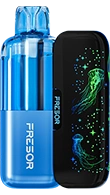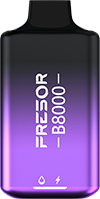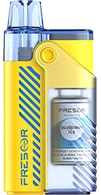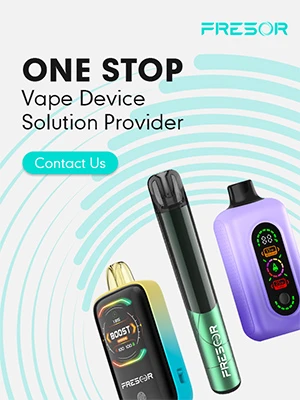Do Nicotine-free Vapes Help You Quit Smoking Cigarettes

16 May 2024

Vaping has emerged as a cultural and health phenomenon since the early 2000s. Many smokers are turning to e-cigarettes as a less harmful alternative to traditional tobacco products. Among these are non-nicotine (nicotine-free/zero nicotine) vapes, which eliminate the addictive substance while supposedly maintaining the act of smoking. However, as this sector progresses, a new question arises. Do none nicotine vapes help you quit smoking? Let's explore the answer.
What Are Nicotine-Free Vapes?
Nicotine-free vapes are e-cigarettes that deliver flavored vapor without containing nicotine, the highly addictive substance found in traditional cigarettes. Manufacturers design these devices to mimic the act of smoking, offering a similar sensory experience without exposing the user to nicotine.
Non-nicotine vapes work through a battery-powered device that heats the e-liquid to create vapor, which the user then inhales. Users inhale and exhale vapor, which typically consists of propylene glycol, vegetable glycerine, flavorings, and sometimes water.
Differences Between Nicotine and Non-Nicotine Vapes
The main differences between nicotine and non-nicotine vapes are as follows:
Nicotine vapes contain nicotine, a highly addictive substance, while non-nicotine vapes do not.
Non-nicotine vapes are perceived as less harmful due to the absence of nicotine, although the long-term health effects are still under research.
Regulations regarding the sale and use of vapes vary by region and often differ based on nicotine content, affecting the availability of nicotine vs. non-nicotine products.
Both types of vapes offer a variety of flavors, but the experience may vary. Some users report a difference in throat hit and satisfaction between nicotine and non-nicotine options.
Is Vaping Without Nicotine Safe?
Vaping products without nicotine can indeed be a tool to help smokers quit, offering a way to mimic the act of smoking without the addictive nicotine. However, it's important to note that even nicotine-free vaping is not without its potential side effects.
While eliminating nicotine reduces the risk of addiction, users may still experience adverse effects on their throat, which can lead to lung disease and overall respiratory system. Ingredients such as propylene glycol and vegetable glycerin, commonly found in vape juices, can lead to irritation in the throat and lungs over time.
Do No Nicotine Vapes Help You in Quitting Smoking?

Determining whether non-nicotine vapes aid in quitting smoking isn't straightforward; it varies based on personal smoking behaviors and the desire to stop.
Effectiveness of Non-Nicotine Vapes in Cessation Process
Research shows that non-nicotine vapes can be effective in helping individuals reduce their nicotine intake and eventually quit smoking. A study published in the Journal of Medical Internet Research found that non-nicotine vape users reported a reduction in cigarette consumption and cravings, as well as an increase in motivation to quit smoking.
Another study published in Nicotine & Tobacco Research showed that using non-nicotine vapes was associated with a higher likelihood of quitting smoking compared to using traditional nicotine replacement therapies.
Psychological Factors
Apart from the nicotine addiction, smoking also has a vital psychological component. For many individuals, smoking serves as a coping mechanism for stress and anxiety. In this case, vapes may not be as effective in helping quit smoking as they do not address the underlying psychological factors.
User Experiences
While research shows promise in using non-nicotine vapes for smoking cessation, user experiences vary. Some individuals report success in using electronic nicotine delivery systems to quit smoking, while others find it challenging to break the habit entirely.
Vaping Vs. Smoking Cigarettes

When comparing vaping to smoking cigarettes, especially in the context of smoking cessation among adult smokers, it's crucial to consider both the physical and psychological implications. Cigarette smoking is well-documented for its severe health risks, including cancer, heart disease, and respiratory problems, mainly due to the combustion process releasing thousands of harmful chemicals.
Vaping, seen as a modern alternative, eliminates combustion, possibly reducing exposure to these toxic substances. However, while vaping may present fewer physical health risks, the psychological battle against addiction remains formidable. For adult smokers, the act of vaping can mimic the habit of cigarette smoking, potentially easing the transition away from tobacco products.
Nonetheless, the absence of nicotine in non-nicotine vapes may not fully address the nicotine dependence aspect of the addiction. It's also essential to consider the long-term health effects of vaping, which are still under investigation. While vaping may offer a pathway towards smoking cessation, it's not a risk-free solution.
Cigarette smokers looking to quit should seek comprehensive support, including behavioral therapies and nicotine replacement strategies, to address both the habit and the addiction comprehensively.
Nicotine Free Vape Vs Nicotine Replacement Therapy

When comparing nicotine-free vapes to Nicotine Replacement Therapy (NRT), several key differences emerge, shaping their effectiveness in helping individuals transition away from smoking tobacco.
Experience
Nicotine-free vapes offer a sensory experience resembling that of smoking electronic cigarettes without delivering nicotine, potentially reducing nicotine cravings without the associated risks of nicotine consumption. On the other hand, NRT directly supplies the body with controlled quantities of nicotine to alleviate withdrawal symptoms, aiming to gradually wean the user off their dependence without the act of smoking.
Nicotine Cravings Management
Nicotine-free vapes may not directly satisfy nicotine cravings but can psychologically mimic the act of smoking, helping to manage cravings. NRT, however, directly addresses nicotine cravings by supplying nicotine in reduced doses, making it arguably more effective for immediate relief.
Health Risks
While both strategies aim to reduce the health risks associated with smoking tobacco, nicotine-free vapes remove the risk of nicotine addiction. Yet, concerns remain about the inhalation of propylene glycol, vegetable glycerin, and potentially toxic volatile organic chemicals present in the flavors of vapes. NRTs, being FDA-approved, have been extensively researched and are considered safe, though they maintain the user's exposure to nicotine.
Ease of Transition
Transitioning to nicotine-free vapes may be more appealing for individuals who wish to maintain the physical act of smoking without the harmful effects of tobacco combustion. In contrast, NRT requires a behavioral shift away from the ritual of tobacco, focusing instead on eliminating physical dependence on nicotine.
Benefits of Nicotine-Free Vaping

Aside from aiding in the cessation process, nicotine-free vaping may have other potential benefits, such as:
Reduced Nicotine Consumption: For those who are not yet ready to quit smoking altogether, using non-nicotine vapes can be a way to reduce nicotine intake and potentially lead to quitting altogether.
Cost Savings: Vaping without nicotine can be more cost-effective compared to traditional cigarettes and even nicotine-based vapes, as the user is not constantly purchasing nicotine refills or cartridges.
Customization: Non-nicotine vapes offer a wide range of flavor options, allowing users to customize their vaping experience according to their preferences.
Social Acceptance: With the growing social stigma around smoking, non-nicotine vapes offer a more socially acceptable alternative that does not expose others to harmful secondhand smoke.
Less Harmful Alternative: While more research is needed, some studies suggest that vaping without nicotine may be less harmful than smoking traditional cigarettes. This could make it a potential harm-reduction tool for individuals who are unable or unwilling to quit smoking altogether.
Drawbacks of Nicotine-Free Vaping
While there are potential benefits of using non-nicotine vapes, there are also some drawbacks to consider, such as:
Health Problems: As mentioned earlier, the ingredients in vape juices can have adverse effects on the respiratory system over time. Additionally, as vaping is a relatively new phenomenon, there is still limited research on its long-term health effects.
Gateway to Nicotine Use: Some argue that non-nicotine vapes can be a gateway for young people to start using nicotine-based vapes or traditional cigarettes.
Lack of Regulation: Unlike NRTs, which the FDA regulates, there is currently little regulation on the ingredients and production of non-nicotine vape juices. This raises concerns about potential unknown health risks.
Addiction to the Act of Smoking: Non-nicotine vapes may not address the psychological dependency on the act of smoking, making it difficult for some individuals to quit smoking altogether.
Practical Strategies to Quit Smoking

While non-nicotine vapes may be a valuable tool in the smoking cessation process, there are other strategies individuals can use to quit smoking altogether. Some effective methods include:
Nicotine Nasal Spray
For smokers who have an intense dependence on nicotine, the nasal spray can be a potent method of quitting. The spray delivers a targeted dose of nicotine to the bloodstream, providing rapid relief from withdrawal symptoms. This method is beneficial for heavy smokers who may find other nicotine replacement techniques ineffective due to the immediate need for a nicotine hit.
However, the nasal spray should be used under the guidance of a healthcare professional, as it can lead to nasal irritation and other side effects if not used correctly. Despite these potential downsides, the nasal spray has proven to be one of the most successful methods for heavy smokers looking to quit.
Nicotine Patches
Nicotine replacement therapy (NRT) can take the form of a patch that delivers controlled, low doses of nicotine through the skin. Patches work by gradually reducing nicotine intake, thus reducing withdrawal symptoms without the need to smoke. They can be an excellent choice for those who prefer a discreet and continuous method of treatment.
To implement this strategy effectively, start by identifying a 'quit day.' On that day, apply a patch as part of your morning routine, ensuring a steady stream of nicotine to help manage cravings throughout the day. Users gradually decrease the strength of the patches over several weeks until they are no longer using nicotine at all.
Lozenges
Nicotine lozenges are another form of NRT that provides a slower but steady release of nicotine. Users should place the tablet in their mouth and allow it to dissolve slowly without chewing or swallowing it. This method is excellent for those who find the chronic nature of smoking challenging to break; the act of having something in the mouth and the self-administration can help mimic the experience of smoking.
Additionally, the tablets come in various strengths, which allow the user to tailor their usage to their level of addiction, providing a flexible approach to quitting. It is advisable not to use more than 20 tablets per day and to follow a step-down plan as cessation is achieved.
Nicotine Gum
Nicotine gum is a popular NRT option that allows the user to chew the gum in a specific manner to release nicotine into the system. This method is well-suited for those looking to address both oral fixation and the physical addiction to nicotine.
With this strategy, the user starts with a higher dose of nicotine gum and then progressively adjusts to lower doses. Like tablets, it's vital not to chew the gum like regular gum but instead to 'park' the gum between the cheek and gum to allow the nicotine to be absorbed properly.
Medications like Bupropion and Varenicline can also be prescribed to help control the craving for nicotine or its withdrawal symptoms. These drugs can be an essential part of a comprehensive cessation plan and are particularly helpful for those who might find it difficult to adhere strictly to an NRT routine.
Takeaway
While non-nicotine vapes present a less harmful alternative for those looking to quit smoking, they are not a one-size-fits-all solution. Strategies for quitting smoking vary widely in effectiveness and personal suitability, ranging from nicotine replacement therapies to prescription medications. It is crucial for individuals seeking to quit smoking to consider all available options, weighing the benefits and drawbacks of each. The journey to quit smoking is a personal one, requiring a combination of determination, support, and the right cessation strategy to achieve success.

























